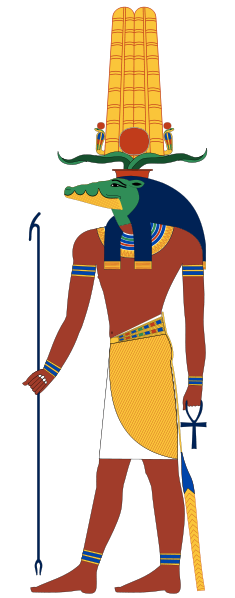

Sobek (also called Sebek, Sochet, Sobk, Sobki, Soknopais, and in Greek, Suchos) Sobek was the deification of crocodiles which were feared in a nation so dependent on the Nile River. Egyptians who worked or traveled on the Nile hoped that if they prayed to Sobek, he would protect them from being attacked by crocodiles.
The god Sobek, which was depicted as a crocodile or a man with the head of a crocodile was a powerful and frightening deity; in some Egyptian creation myths, it was Sobek who first came out of the waters of chaos to create the world. As a creator god, he was occasionally linked with the sun god Ra.
Most of Sobek's temples were located "in parts of Egypt where crocodiles were common." Sobek's cult originally flourished around Al Fayyum where some temples still remain; the area was so associated with Sobek that one town, Arsinoe, was known to the Greeks as Crocodilopolis or 'Crocodile Town.'
Another major cult centre was at Kom Ombo, "close to the sandbanks of the Nile where crocodiles liked to bask." Some temples of Sobek kept pools where sacred crocodiles were kept: these crocodiles were fed the best cuts of meat and became quite tame. When they died, they were mummified and buried in special animal cemeteries. In other areas of Egypt, however, crocodiles were dealt with by simply hunting and killing them.
Gradually, Sobek also came to symbolize the produce of the Nile and the fertility that it brought to the land; its status thus became more ambiguous. Sometimes the ferocity of a crocodile was seen in a positive light, Sobek in these circumstances was considered the army's patron, as a representation of strength and power.
Sobek's ambiguous nature led some Egyptian to believe that he was a repairer of evil that had been done, rather than a force for good in itself, for example, going to Duat to restore damage done to the dead as a result of their form of death. He was also said to call on suitable gods and goddesses required for protecting people in situation, effectively having a more distant role, nudging things along, rather than taking an active part.
In this way, he was seen as a more primal god, eventually becoming regarded as an avatar of the primal god Amun, who at that time was considered the chief god. When his identity finally merged, Amun had become merged himself with Ra to become Amun-Ra, so Sobek, as an avatar of Amun-Ra, was known as Sobek-Ra.
In Egyptian Art, Sobek was depicted as an ordinary crocodile, or as a man with the head of a crocodile. When considered a patron of the pharaoh's army, he was shown with the symbol of royal authority - the uraeus. He was also shown with an ankh, representing his ability to undo evil and so cure ills. Once he had become Sobek-Ra, he was also shown with a sun-disc over his head, as Ra was a sun god.
In myths that appear extremely late in Egyptian history, Sobek is credited with catching the four sons of Horus in a net, as they emerged from the waters of the Nile in a lotus blossom. This motif derives from the birth of Ra in the Ogdoad cosmogony, and the fact that as a crocodile, Sobek is the best suited to collecting items upon the Nile. Sobek